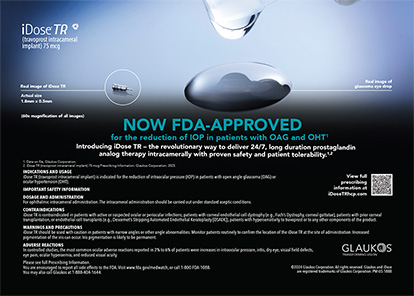I prefer the flip-and-slice technique for cataract surgery. I have found this method of supracapsular cataract disassembly to be safe and efficient, and this article details its steps.
THE INCISIONS
I inject preservative-free lidocaine into the anterior chamber for intracameral anesthesia. Then, I instill Healon EndoCoat (Abbott Medical Optics Inc.) to protect the corneal endothelium. I place Healon5 (Abbott Medical Optics Inc.) immediately underneath this layer to flatten the convex curve of the cataract and minimize the spiraling out of the capsulorhexis. Directly underneath the Healon5, I inject balanced salt solution with a 30-gauge cannula to create my working space for the capsulorhexis. Then, I make the main temporal corneal incision; I use a steel keratome for a tongue-in-groove type of incision, which I find seals well at the end of the case.
FLIPPING THE CATARACT
I puncture the anterior capsule with a cystotome and begin the capsulorhexis using Utrata forceps. I look for a 360º overlap of the optic of the selected IOL. After performing the capsulorhexis, my next step is to gently hydroprolapse the nucleus out of the capsular bag using a flattened hydrodissection cannula.
It is important to “burp” some of the Healon5 out of the eye by depressing the posterior lip of the temporal incision before hydroprolapsing the lens out of the bag. The cataract will pop out of the capsular bag about two-thirds of the way. I then put a ribbon of Healon5 across the equator of the cataract to deepen my working space and to protect the corneal endothelium. I use a Koch Phaco Manipulator to slice and flip the nucleus toward me. This tool is a smooth spatula free of sharp points or edges for added safety. I use the Koch manipulator as a fulcrum at the junction of the lower one-third of the prolapsed lens.
If I slice the nucleus as I am flipping the cataract toward me, I start with the quadrant setting of the WhiteStar Signature System (Abbott Medical Optics Inc.), bypassing the sculpt setting entirely. For cataracts with grade 3 nuclear sclerosis or greater that do not split when I flip them, I start with the sculpt setting and make a few passes directly over the “fault line” or partial split. Then, I crack the nucleus into two hemi-nuclei with my phaco tip and the Koch Manipulator before changing to the quadrant setting.
NUCLEAR REMOVAL
I can remove most cataracts in less than 90 seconds (time the phaco tip is in the eye), with 9% power or less, and in less than 9 seconds of effective phaco time.
For the nucleus' removal, I favor the peristaltic pump, because it holds the fragments with very little repulsion or chatter. Next, I perform I/A with an angled tip with the Venturi setting, which is known for followability. I want the sticky cortex to enter the port without engaging the posterior capsule. I am able to easily remove the cortex, especially the stubborn subincisional section, by approaching it first. Next, I use regular Healon to inflate the capsular bag for IOL implantation.
I try to perform the fewest possible maneuvers inside the eye to minimize complications and preserve the endothelium. I remove the viscoelastic with the venturi pump.
CHOICE AND CUSTOMIZATION
With a dual-pump system, I can instantly switch between peristaltic and venturi modes. I use settings designed to automatically toggle between the two pumps. The combined fluidics of the dual-pump technology and the customizable features of fusion phaco technology help me achieve maximum efficiency and safety for the best visual outcomes.
CASE EXAMPLE
I recently used the flip-and-slice technique and fusion phaco technology on the eyes of a 73-year-old man with a cortical-spoking and nuclear sclerotic cataract. I operated on both eyes about 2 weeks apart and implanted biaspheric acrylic single-piece IOLs.
The accompanying video shows the left (nondominant) eye, which I usually operate on second. I operate on the dominant eye aimed for distance first. This patient's target refraction was -0.74 D for intermediate distance, for which I used a mini-monovision approach for his nondominant eye. The eye had 0.40 D of with-the-rule crossed-cylinder astigmatism, including my surgically induced astigmatism from a temporal corneal incision. The small amount of astigmatism did not require correction at the time of surgery. His right (dominant) eye was targeted for distance at -0.15 D. This eye had 0.31 D of with-the-rule crossed-cylinder astigmatism, including my surgically induced astigmatism from a temporal corneal incision. Again, the small amount of astigmatism did not require correction at the time of surgery.
On postoperative day 1, the patient's distance UCVA was 20/20, intermediate UCVA was 20/20 measured at 32 inches with the Early Treatment Diabetic Retinopathy Study (ETDRS) card, and near UCVA was 20/25. One week postoperatively, his visual acuity was 20/25 at distance, 20/16+ at intermediate, and 20/32+ at near. One month postoperatively, his bilateral distance UCVA was 20/15, his intermediate UCVA was 20/15, and his near UCVA was 20/25+. With +1.50 D readers, his near visual acuity was 20/15. The patient was elated with his result.
Cynthia Matossian, MD, is the founder and CEO of Matossian Eye Associates, with offices in Pennsylvania and New Jersey, and she is a clinical instructor/adjunct faculty member at Temple University School of Medicine in Philadelphia and Robert Wood Johnson Medical School in New Brunswick, New Jersey. She is a consultant to Abbott Medical Optics Inc. Dr. Matossian may be reached at cmatossian@matossianeye.com.


